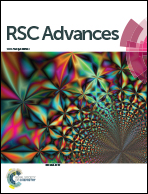Effects of structural, optical and ferromagnetic states on the photocatalytic activities of Sn–TiO2 nanocrystals†
Abstract
The structural, electronic, magnetic and photocatalytic properties of Sn doped TiO2 diluted magnetic semiconductor nanoparticles (NPs) prepared by a simple hydrothermal method were systematically investigated by various conventional techniques and 119Sn Mössbauer spectroscopy. Anatase, mixed (anatase–rutile) and rutile phases of Sn–TiO2 NPs were obtained by adding different amounts of SnCl4 into a titanium nitrate aqueous solution. Photocatalytic degradation of methyl orange and phenol derivatives (RPhOH) were studied under visible and UV light irradiation in water, respectively. The photocatalytic activities of prepared NPs were found to be drastically related to the structural, optical and ferromagnetic properties. A significant relationship was observed between the Hammett substitution constants of RPhOH and the photocatalytic activity. Among all the samples, the anatase phase with low Sn content performed with the best photocatalytic and ferromagnetic characteristics at room temperature.


 Please wait while we load your content...
Please wait while we load your content...